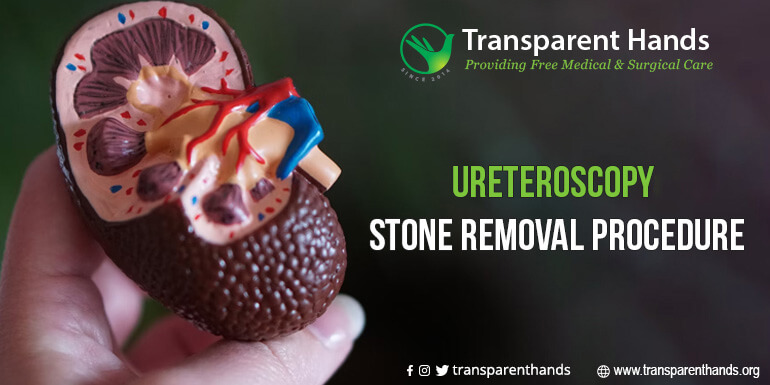Ureteroscopy Stone Removal Procedure

Ureteroscopy (Stone Removal Procedure) is a surgical technique to get rid of kidney stones. The formation of mineral deposits in the kidneys is a common health problem that affects many. These deposits solidify into objects referred to as kidney stones. Kidney stones may result in intense pain and compromise renal function. Some of the causes of kidney stones include a poor diet, poor quality of drinking water, and underlying health conditions such as goiter. If not taken care of, kidney stones can cause irreversible kidney damage. One of the treatments advised by doctors is ureteroscopy. Here’s everything you need to know about ureteroscopy.
When to Consult a Urologist?
If you have severe pain in your back, blood in the urine, foul-smelling urine, or a cloudy appearance of the urinal discharge, it is likely to be associated with kidney conditions. A timely visit to the urologist may save you from further suffering. Urologists specialize in diagnosing and treating urinary tract-related problems. In case you have kidney stones, they would also study the size and the location of the kidney stone. For a thorough examination, an MRI scan shows detailed images. You may also need urine testing for potential infections such as coliforms.
What to Expect While Undergoing a Ureteroscopy Procedure?
Let’s begin with the structure and physiology of the. We are all familiar with the appearance of kidneys – a bean-shaped organ. The bulged side of each kidney terminates on a cone-like structure called the renal pelvis. The renal pelvis continues to a narrow tube, ureter. Kidney stones build up in the kidneys and translocate to ureters. There they may block urine passage and cause serious complications. Both ureters are connected to the bladder, which ends in the urethra, the opening for urine discharge.
The ureteroscopy procedure is performed under anesthesia. Hence, the staff performing the procedure also requires an anesthesiologist. During ureteroscopy, a urologist inserts a flexible endoscope into the bladder and ureter. Once it reaches the bladder, the urologist fills the bladder with fluid through the tube. The sterile fluid aids in acquiring clear images of the internal organ. Then they guide the tube up to the ureter (or kidney if required). Along with internal visualization, the tube-like scope grabs and collects the stones in a small basket structure. However, ureteroscopy does not always involve a basket.
Ureteroscopy removes smaller stones directly. However, when there are larger stones, it may be accompanied by laser-assisted fragmentation of kidney stones.
The procedure takes less time if the purpose is to examine the urinary tract with the endoscope. However, it takes a longer duration if done to remove kidney stones. The whole procedure spans 30-90 minutes, depending on the size of the kidney stones. After removing the ureteroscope, the fluid is also emptied.
Precautions After Getting a Stone Removal Procedure
The anesthesia typically wears off in approximately 1-4 hours. For the first few days, you will get prescriptions for antibiotics to avoid infections. Fever or aggravated pain may indicate infection. Therefore, notify your doctor if you experience these symptoms.
Mild to moderate pain after the ureteroscopy is normal. During the first two hours after the procedure, the doctors recommend drinking 16 ounces of water each hour. Observing a little blood in the urine for the next few hours is normal. However, the pain and discomfort must ease by the next day. If you have persistent pain, consult your healthcare provider.
When is it Recommended to Get a Ureteroscopy?
The choice of treatment depends on different factors, including the composition of kidney stones and the location of kidney stones. Some kidney stones do not require surgical removal. Instead, they can be dissolved and eliminated via urine. Drinking plenty of water and taking prescribed alkaline syrups help dissolve kidney stones. However, some kidney stones are hard to remove. They either need ureteroscopy or extracorporeal lithotripsy.
Ways to Prevent Formation of Kidney Stones
Difference Between Extracorporeal Lithotripsy & Ureteroscopy
Ureteroscopy is an invasive procedure, while extracorporeal lithotripsy is non-invasive. Extracorporeal refers to performing the procedure from outside the body. In extracorporeal lithotripsy, ultrasound waves are directed towards the target location from the outside. The waves penetrate the skin and reach the internal structures. The healthcare provider regulates the intensity and duration of the waves. This shockwave treatment breaks kidney stones into smaller fragments that can pass through the urine. Unlike ureteroscopy, it does not require general anesthesia.
Lithotripsy is less expensive than ureteroscopy as it does not involve complex equipment. Due to non-invasiveness, the recovery time is also shorter. Now you must be thinking, why don’t all the patients get lithotripsy? Well, there are limitations to lithotripsy. It cannot remove all types of kidney stones.
As discussed earlier, stones are of different compositions. Some of these cannot be fragmented with extracorporeal lithotripsy. Moreover, some fragmented stones do not always easily pass through the ureters. Therefore, some sticky depositions may cause more complications. In such cases, ureteroscopy is a more efficient way to remove kidney stones. Ureteroscopy is a preferred treatment for stones located in the lower part of the urinary tract, i.e., ureters and near the bladder.
Risks and Benefits of Ureteroscopy
The potential risks of ureteroscopy include internal injuries and infections. However, the benefits outweigh the risks. It is an efficient method for removing kidney stones. Additionally, ureteroscopy provides a clear internal view for the inspection of the disease. Besides stone removal, ureteroscopy is also employed to take biopsy samples.
Since many patients, especially in developing countries like Pakistan, cannot afford to pay for ureteroscopy due to financial constraints, Transparent Hands provides this procedure to deserving patients free of charge. Join hands with us to help thousands of patients belonging to underprivileged communities all across the country. Donate Now
(The information in this article should not be taken as a substitute for professional medical advice.)










Leave a Reply